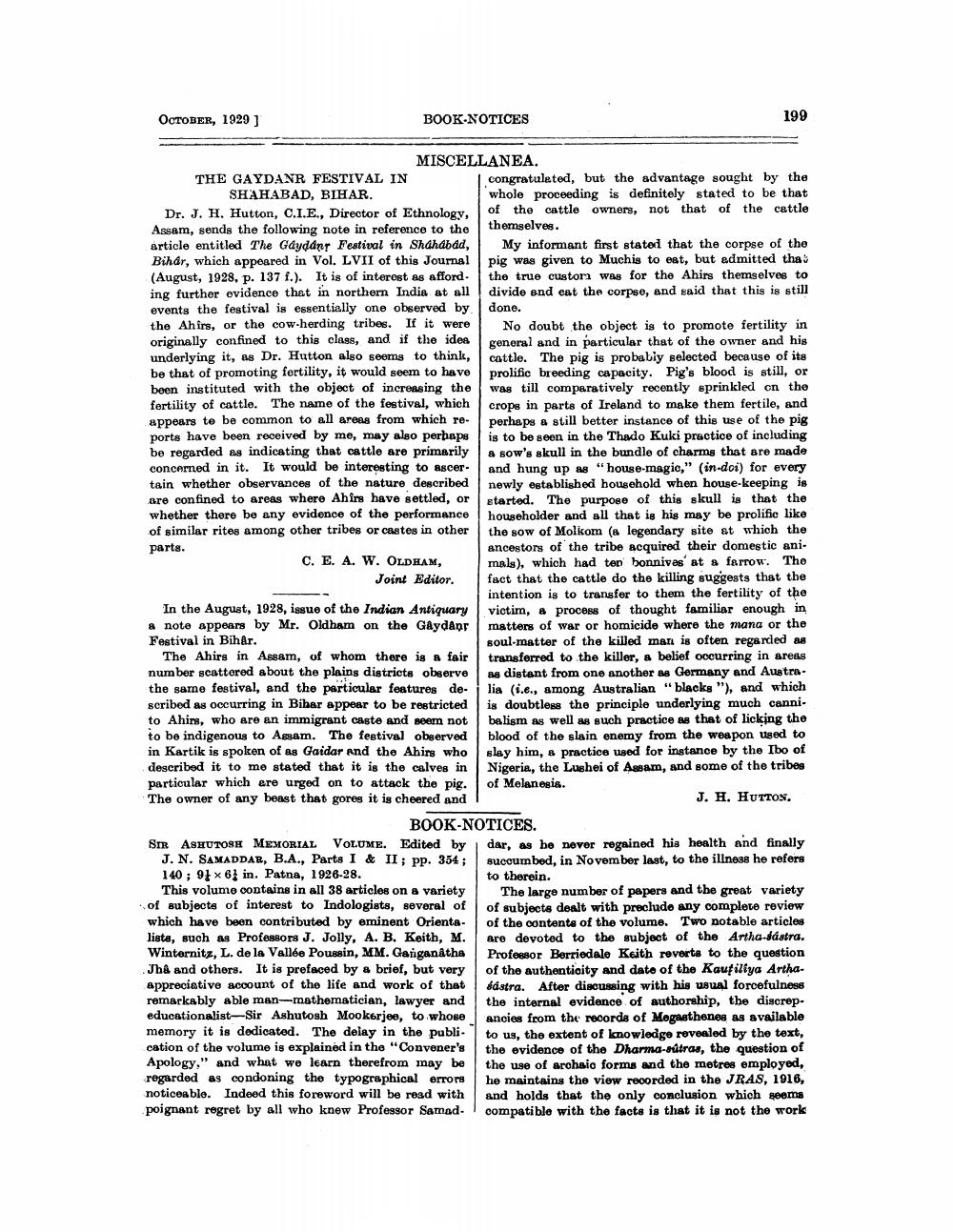________________
OCTOBER, 1929 ]
THE GAYDANR FESTIVAL IN SHAHABAD, BIHAR.
BOOK-NOTICES
MISCELLANEA.
Dr. J. H. Hutton, C.I.E., Director of Ethnology, Assam, sends the following note in reference to the article entitled The Gaydánr Festival in Shahabad, Bihar, which appeared in Vol. LVII of this Journal (August, 1928, p. 137 f.). It is of interest as affording further evidence that in northern India at all events the festival is essentially one observed by the Ahirs, or the cow-herding tribes. If it were originally confined to this class, and if the idea underlying it, as Dr. Hutton also seems to think, be that of promoting fertility, it would seem to have been instituted with the object of increasing the fertility of cattle. The name of the festival, which appears to be common to all areas from which reports have been received by me, may also perhaps be regarded as indicating that cattle are primarily concerned in it. It would be interesting to ascertain whether observances of the nature described are confined to areas where Ahirs have settled, or whether there be any evidence of the performance of similar rites among other tribes or castes in other parts. C. E. A. W. OLDHAM, Joint Editor.
In the August, 1928, issue of the Indian Antiquary a note appears by Mr. Oldham on the Gaydânṛ Festival in Bihar.
The Ahirs in Assam, of whom there is a fair number scattered about the plains districts observe the same festival, and the particular features described as occurring in Bihar appear to be restricted to Ahirs, who are an immigrant caste and seem not to be indigenous to Assam. The festival observed in Kartik is spoken of as Gaidar and the Ahirs who described it to me stated that it is the calves in particular which are urged on to attack the pig. The owner of any beast that gores it is cheered and
SIR ASHUTOSH MEMORIAL VOLUME. Edited by J. N. SAMADDAR, B.A., Parts I & II; pp. 354; 140; 91x61 in. Patna, 1926-28.
This volume contains in all 38 articles on a variety of subjects of interest to Indologists, several of which have been contributed by eminent Orientalists, such as Professors J. Jolly, A. B. Keith, M. Winternitz, L. de la Vallée Poussin, MM. Ganganatha Jha and others. It is prefaced by a brief, but very appreciative account of the life and work of that remarkably able man-mathematician, lawyer and educationalist-Sir Ashutosh Mookerjee, to whose memory it is dedicated. The delay in the publi. cation of the volume is explained in the "Convener's Apology," and what we learn therefrom may be regarded as condoning the typographical errors noticeable. Indeed this foreword will be read with poignant regret by all who knew Professor Samad
199
congratulated, but the advantage sought by the whole proceeding is definitely stated to be that of the cattle owners, not that of the cattle themselves.
My informant first stated that the corpse of the pig was given to Muchis to eat, but admitted tha the true custorm was for the Ahirs themselves to divide and eat the corpse, and said that this is still done.
BOOK-NOTICES.
No doubt the object is to promote fertility in general and in particular that of the owner and his cattle. The pig is probably selected because of its prolific breeding capacity. Pig's blood is still, or was till comparatively recently sprinkled on the crops in parts of Ireland to make them fertile, and perhaps a still better instance of this use of the pig is to be seen in the Thado Kuki practice of including a sow's skull in the bundle of charms that are made and hung up as "house-magic," (in-doi) for every newly established household when house-keeping is started. The purpose of this skull is that the householder and all that is his may be prolific like the sow of Molkom (a legendary site at which the ancestors of the tribe acquired their domestic animals), which had ten bonnives at a farrow. The fact that the cattle do the killing suggests that the intention is to transfer to them the fertility of the victim, a process of thought familiar enough in matters of war or homicide where the mana or the soul-matter of the killed man is often regarded as transferred to the killer, a belief occurring in areas as distant from one another as Germany and Australia (i.e., among Australian "blacks "), and which is doubtless the principle underlying much cannibalism as well as such practice as that of licking the blood of the slain enemy from the weapon used to slay him, a practice used for instance by the Ibo of Nigeria, the Lushei of Assam, and some of the tribes of Melanesia.
J. H. HUTTON.
dar, as he never regained his health and finally succumbed, in November last, to the illness he refers to therein.
The large number of papers and the great variety of subjects dealt with preclude any complete review of the contents of the volume. Two notable articles are devoted to the subject of the Artha-dástra. Professor Berriedale Keith reverts to the question of the authenticity and date of the Kaufiliya Arthaéástra. After discussing with his usual forcefulness the internal evidence of authorship, the discrepancies from the records of Megasthenes as available to us, the extent of knowledge revealed by the text, the evidence of the Dharma-sutras, the question of the use of archaic forms and the metres employed, he maintains the view recorded in the JRAS, 1916, and holds that the only conclusion which seems compatible with the facts is that it is not the work




